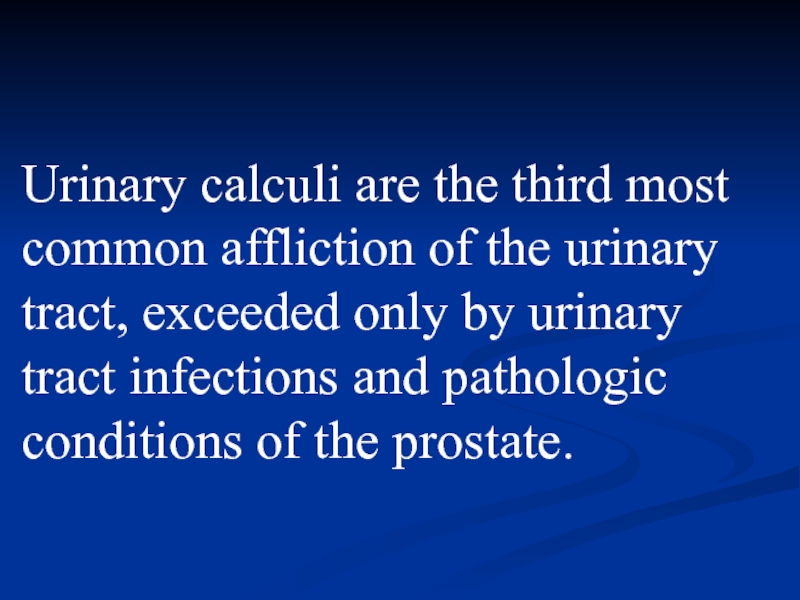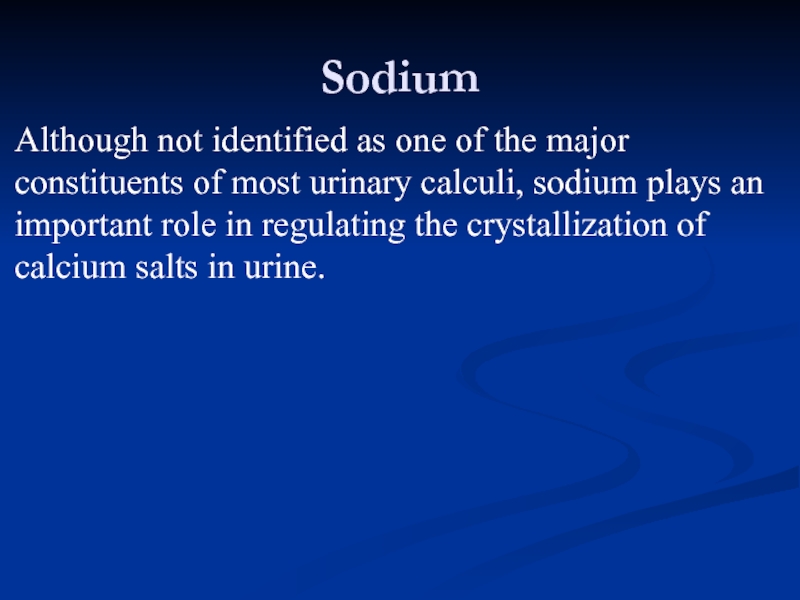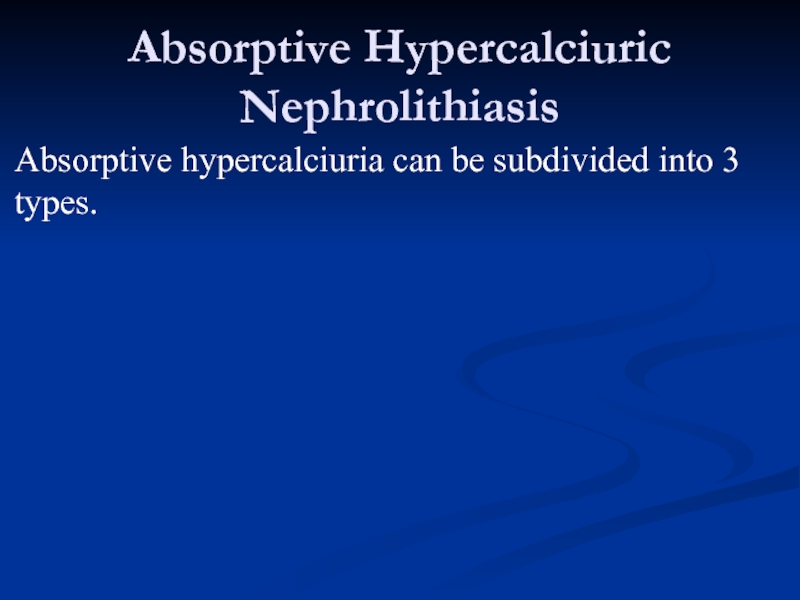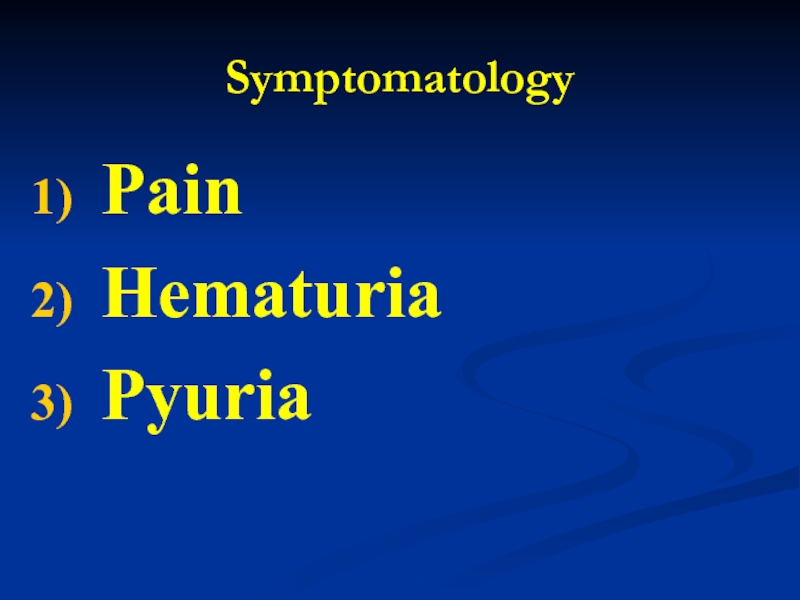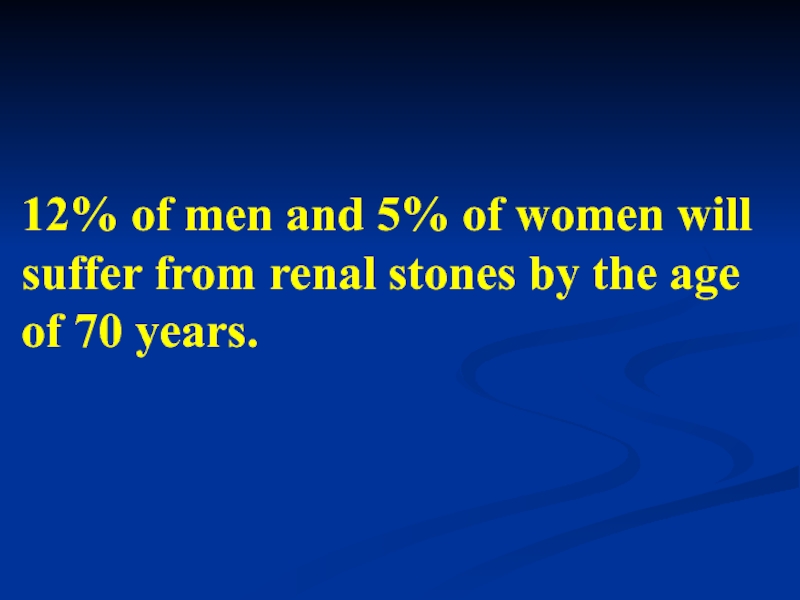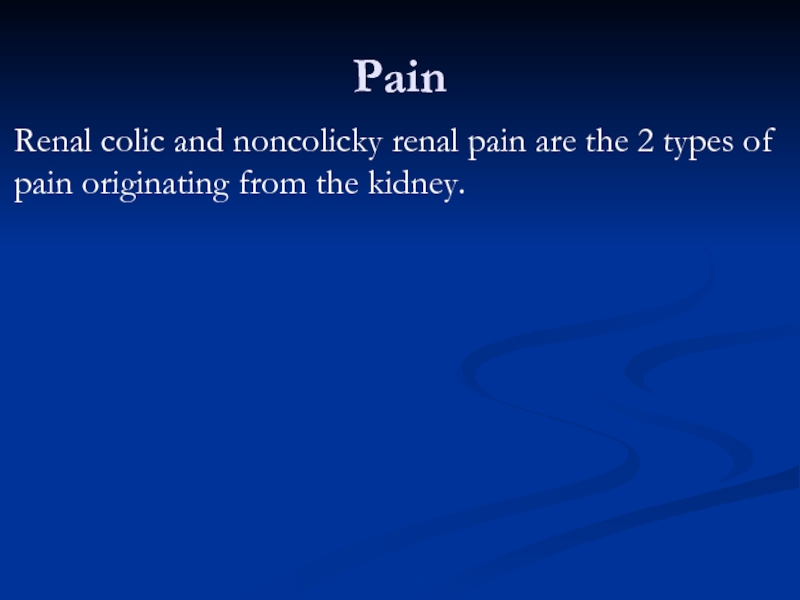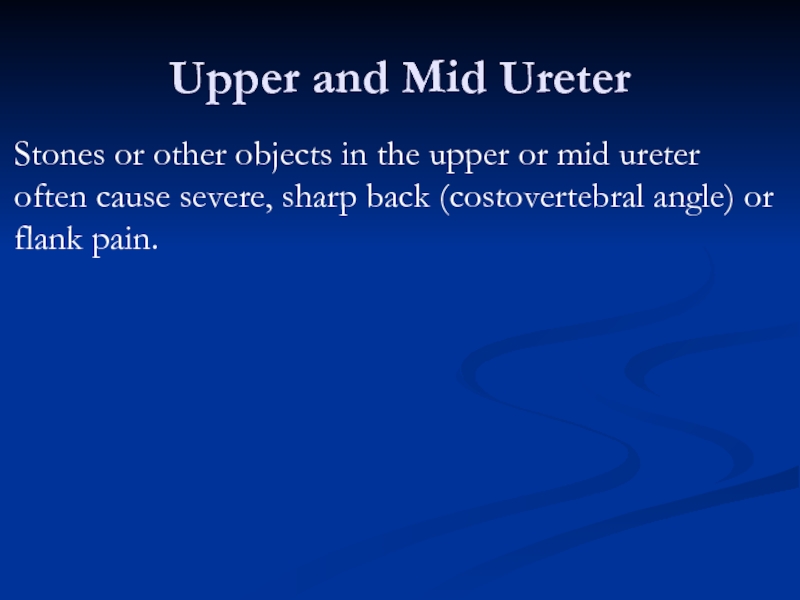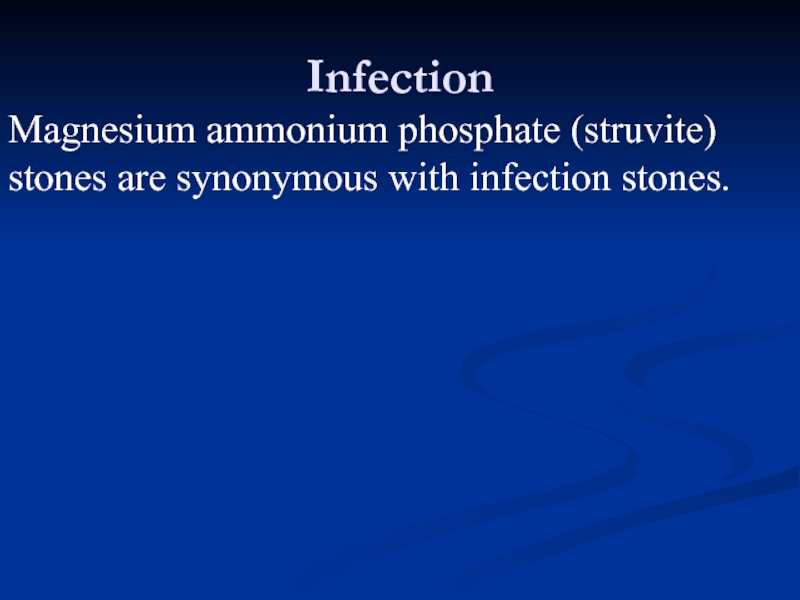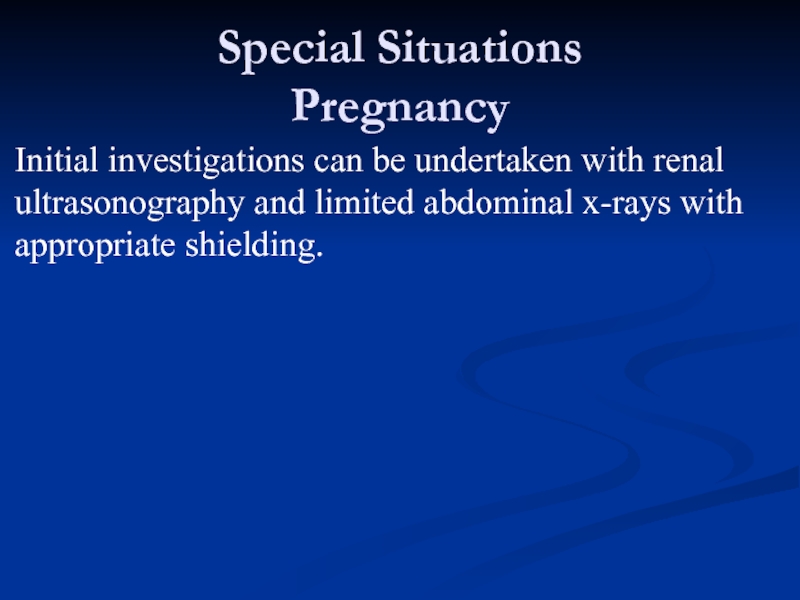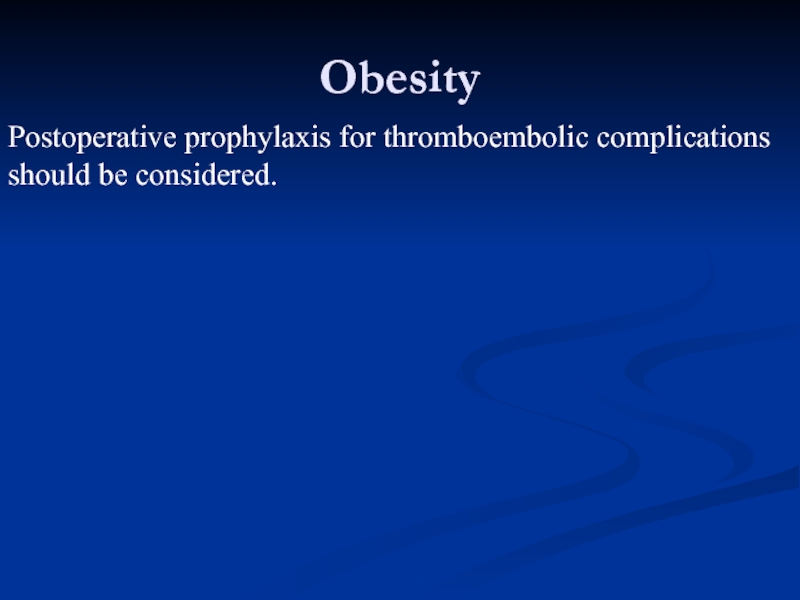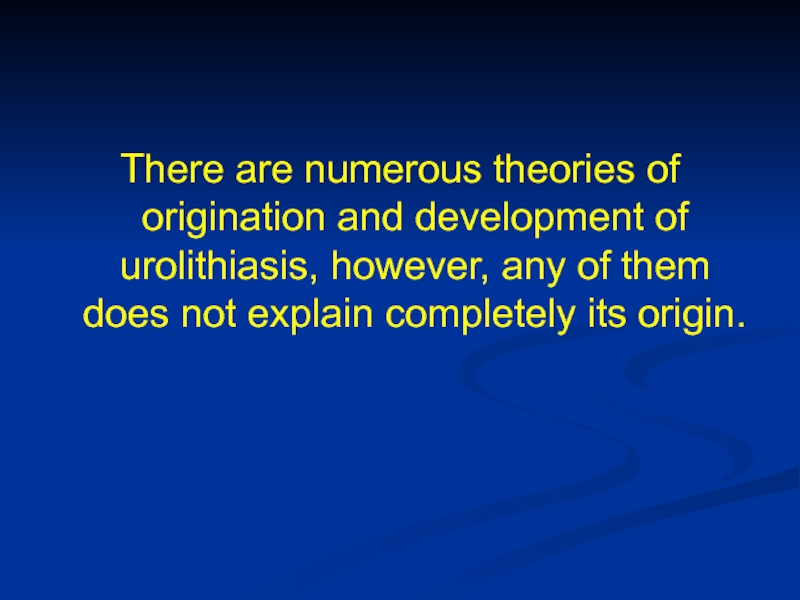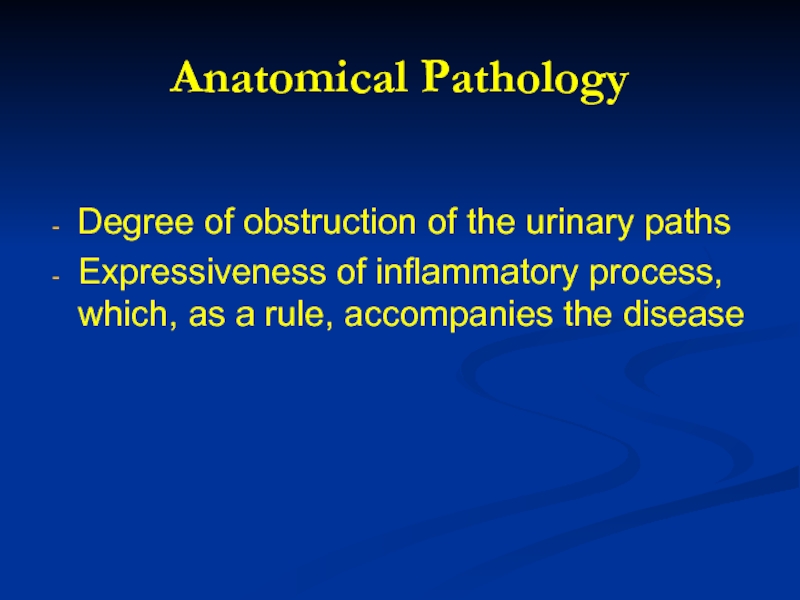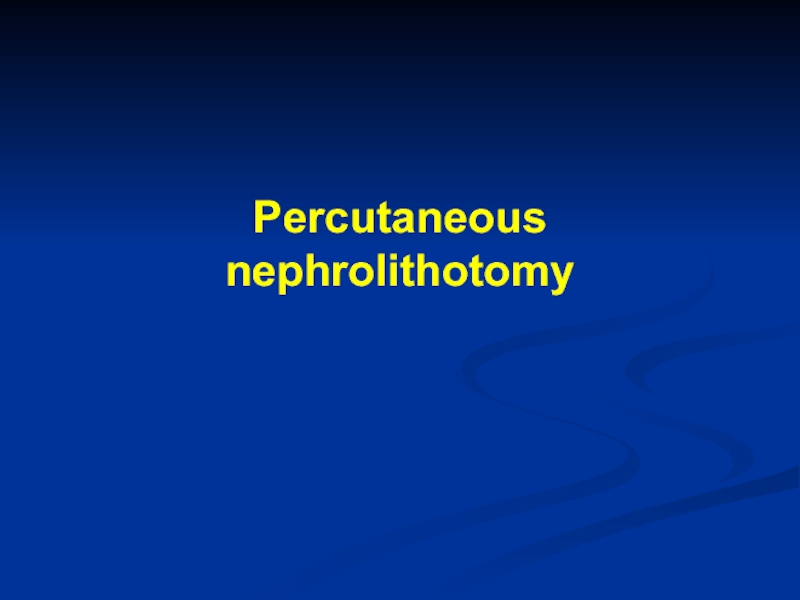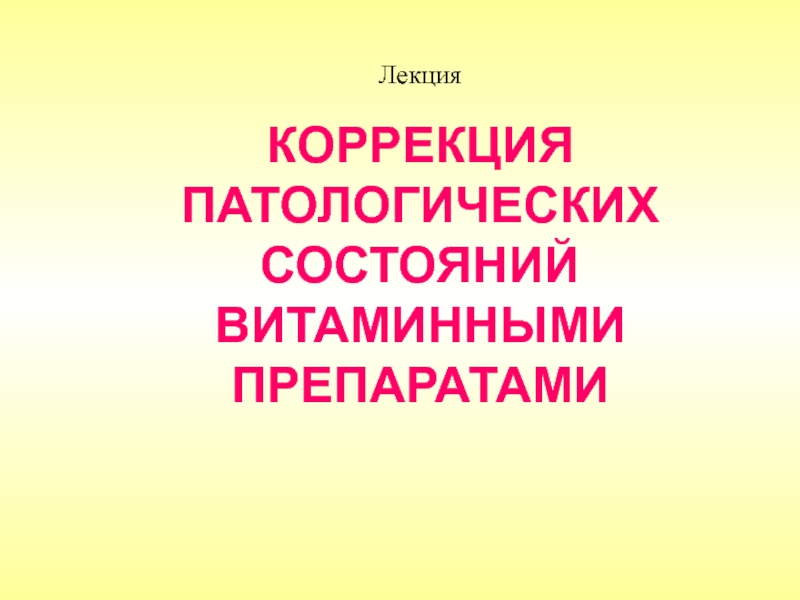- Главная
- Разное
- Дизайн
- Бизнес и предпринимательство
- Аналитика
- Образование
- Развлечения
- Красота и здоровье
- Финансы
- Государство
- Путешествия
- Спорт
- Недвижимость
- Армия
- Графика
- Культурология
- Еда и кулинария
- Лингвистика
- Английский язык
- Астрономия
- Алгебра
- Биология
- География
- Детские презентации
- Информатика
- История
- Литература
- Маркетинг
- Математика
- Медицина
- Менеджмент
- Музыка
- МХК
- Немецкий язык
- ОБЖ
- Обществознание
- Окружающий мир
- Педагогика
- Русский язык
- Технология
- Физика
- Философия
- Химия
- Шаблоны, картинки для презентаций
- Экология
- Экономика
- Юриспруденция
Urolithiasis презентация
Содержание
- 1. Urolithiasis
- 2. Urinary calculi are the third most common
- 3. The nomenclature associated with urinary stone disease arises from a variety of disciplines. .
- 4. Before the time of von Struve, the
- 5. The history of the nomenclature associated with
- 6. Urinary stones have plagued humans since the
- 7. Advances in the surgical treatment of urinary
- 8. Without such follow-up and medical intervention, stone
- 9. Renal & Ureteral Stones Etiology Theories to explain urinary stone disease are incomplete.
- 10. Renal & Ureteral Stones Etiology Stone formation
- 11. Renal & Ureteral Stones Etiology The activity
- 12. Renal & Ureteral Stones Etiology Concentrations above
- 13. Renal & Ureteral Stones Etiology Multiplying 2
- 14. Renal & Ureteral Stones Etiology Crystal formation
- 15. Renal & Ureteral Stones Etiology The nucleation
- 16. Renal & Ureteral Stones Etiology Additionally, many
- 17. Renal & Ureteral Stones Etiology This theory
- 18. Crystal Component Stones are composed primarily of
- 19. Crystal Component Multiple steps are involved in crystal formation, including nucleation, growth, and aggregation.
- 20. Crystal Component A crystal of one type
- 21. Crystal Component How these early crystalline structures
- 22. Crystal Component This explanation is unsatisfactory; tubules
- 23. Crystal Component The fixed particle theory postulates
- 24. Crystal Component These can be appreciated during endoscopy of the upper urinary tract.
- 25. Matrix Component The amount of the noncrystalline,
- 26. Matrix Component Histologic inspection reveals laminations with scant calcifications.
- 27. Matrix Component The role of matrix in
- 28. Urinary Ions Calcium Calcium is a major ion present in urinary crystals.
- 29. Diuretic medications may exert a hypocalciuric effect by further decreasing calcium excretion.
- 30. Oxalate Oxalate is a normal waste product of metabolism and is relatively insoluble.
- 31. Oxalate Once absorbed from the small bowel,
- 32. Oxalate Normal excretion ranges from 20 to
- 33. Oxalate Hyperoxaluria may develop in patients with
- 34. Oxalate The unbound oxalate is readily absorbed.
- 35. Phosphate Phosphate is an important buffer and complexes with calcium in urine.
- 36. Phosphate The small amount of phosphate filtered
- 37. Uric Acid Uric acid is the by-product
- 38. Uric Acid Rarely, a defect in xanthine
- 39. Uric Acid This results from a deficiency of adenine phosphoribosyltransferase (APRT).
- 40. Sodium Although not identified as one of
- 41. Sodium This reduces the ability of urine to inhibit calcium oxalate crystal agglomeration.
- 42. Citrate Citrate is a key factor affecting the development of calcium urinary stones.
- 43. Citrate Metabolic stimuli that consume this product
- 44. Magnesium Dietary magnesium deficiency is associated with
- 45. Magnesium The exact mechanism whereby magnesium exerts its effect is undefined.
- 46. Sulfate Urinary sulfates may help prevent urinary calculi. They can complex with calcium.
- 47. Stone Varieties
- 48. Calcium Calculi Calcifications can occur and accumulate
- 49. Calcium Calculi Hyperuricosuria is identified as a
- 50. Calcium Calculi Finally, decreased urinary citrate is
- 51. Calcium Calculi Symptoms are secondary to obstruction,
- 52. Calcium Calculi Most patients with nephrolithiasis, however, do not have obvious nephrocalcinosis.
- 53. Calcium Calculi Nephrocalcinosis may result from a variety of pathologic states.
- 54. Calcium Calculi Disease processes resulting in bony
- 55. Absorptive Hypercalciuric Nephrolithiasis Normal calcium intake averages approximately 900-1000 mg/d.
- 56. Absorptive Hypercalciuric Nephrolithiasis This results in an
- 57. Absorptive Hypercalciuric Nephrolithiasis Absorptive hypercalciuria can be subdivided into 3 types.
- 58. Absorptive Hypercalciuric Nephrolithiasis Urinary calcium excretion returns to normal values with therapy.
- 59. Symptoms & Signs at Presentation
- 60. Symptomatology Pain Hematuria Pyuria
- 61. 12% of men and 5% of women
- 62. The majority of patients with nephrolithiasis are
- 63. By localization there can be stones of the: -Calices -
- 64. Upper-tract urinary stones usually eventually cause
- 65. Radiation of pain with various types of ureteral stone.
- 66. Upper right: Midureteral stone. Same as above
- 67. Pain Renal colic and noncolicky renal pain
- 68. Pain This pain is due to a direct increase in intraluminal pressure, stretching nerve endings.
- 69. Pain Renal colic does not always wax
- 70. Pain In the ureter, however, local pain
- 71. Pain The vast majority of urinary stones
- 72. Pain The stone burden does not
- 73. Pain The pain frequently is abrupt in
- 74. Pain This movement is in contrast to
- 75. Renal Calyx Stones or other objects in
- 76. Renal Calyx Radiographic imaging may not reveal
- 77. Renal Calyx Caliceal calculi occasionally result in
- 78. Renal Calyx Effective long-term treatment requires stone extraction and elimination of the obstructive component.
- 79. Renal Pelvis Stones in the renal pelvis
- 80. Renal Pelvis Symptoms frequently occur on an
- 81. Renal Pelvis Partial or complete staghorn calculi
- 82. Upper and Mid Ureter Pain associated with
- 83. Upper and Mid Ureter The pain of
- 84. Upper and Mid Ureter Stones or other
- 85. Distal Ureter Calculi in the lower ureter
- 86. Distal Ureter Stones in the intramural ureter
- 87. Distal Ureter Strictures of the distal ureter
- 88. Hematuria A complete urinalysis helps to confirm
- 89. Infection Magnesium ammonium phosphate (struvite) stones are synonymous with infection stones.
- 90. Infection All stones, however, may be associated
- 91. Infection Uropathogenic bacteria may alter ureteral peristalsis
- 92. Infection Local inflammation from infection can lead
- 93. Pyonephrosis Presentation is variable and may range
- 94. Pyonephrosis Radiographic investigations are frequently nondiagnostic.
- 95. Pyonephrosis If unrecognized and untreated, pyonephrosis may develop into a renocutaneous fistula.
- 96. Xanthogranulomatous Pyelonephritis Xanthogranulomatous pyelonephritis is associated with upper-tract obstruction and infection.
- 97. Xanthogranulomatous Pyelonephritis Open surgical procedures, such as
- 98. Associated Fever Costovertebral angle tenderness may be
- 99. Associated Fever If retrograde manipulations are unsuccessful, insertion of a percutaneous nephrostomy tube is required.
- 100. Nausea and Vomiting Effective ureteral peristalsis requires
- 101. Special Situations Pregnancy Renal colic is the
- 102. Special Situations Pregnancy The increased filtered load
- 103. Special Situations Pregnancy Initial investigations can be
- 104. Special Situations Pregnancy Treatment requires balancing the
- 105. Obesity Ultrasound examination is hindered by the attenuation of ultrasound beams.
- 106. Obesity Standard lithotripters have focal lengths less
- 107. Obesity A preplaced heavy suture eases removal of such sheaths.
- 108. Obesity Postoperative prophylaxis for thromboembolic complications should be considered.
- 109. There are numerous theories of origination
- 110. The known role in the etiology
- 111. It is possible to divide the
- 112. The formation of phosphate stones is promoted also by fractures of tubular bones.
- 113. The uric acid is the end product of purine exchange.
- 114. To the internal causes, contributing to
- 115. The local factors of lithogenesis
- 116. 70-80% of all stones are Ca
- 117. Three conditions which contribute to the formation
- 118. There are four types of urate urolithiasis: Idiopathic urate urolithiasis
- 119. Formation of stones of uric acid depends on: pH of urine
- 120. Anatomical Pathology Degree of obstruction of
- 121. Complications of urolithiasis The most often complication
- 122. Both chronic pyelonephrosis and pyonephrosis, as well
- 123. The most severe complication of urolithiasis
- 124. Diagnostics The diagnosis of urolithiasis is
- 125. Laboratory research It is necessary to remember,
- 126. Ultrasound investigation
- 127. X-ray examination
- 128. Retrograde ureteropyelography
- 129. Computed tomography
- 130. Differential diagnosis
- 131. Treatment
- 132. Conservative treatment
- 133. Indications for surgical intervention: Urinary obstructions with
- 134. Instrumental methods of treatment
- 135. Percutaneous nephrolithotomy
- 136. Extracorporeal shock wave lithotripsy (ESWL)
- 137. The indications for open surgical treatment are:
Слайд 2Urinary calculi are the third most common affliction of the urinary
tract, exceeded only by urinary tract infections and pathologic conditions of the prostate.
Слайд 3The nomenclature associated with urinary stone disease arises from a variety
of disciplines. .
Слайд 4Before the time of von Struve, the stones were referred to
as guanite, because magnesium ammonium phosphate is prominent in bat droppings.
Слайд 5The history of the nomenclature associated with urinary stone disease is
as intriguing as that of the development of the interventional techniques used in their treatment.
Слайд 6Urinary stones have plagued humans since the earliest records of civilization.
The etiology of stones remains speculative.
Слайд 7Advances in the surgical treatment of urinary stones have outpaced our
understanding of their etiology.
Слайд 8Without such follow-up and medical intervention, stone recurrence rates can be
as high as 50% within 5 years.
Слайд 10Renal & Ureteral Stones
Etiology
Stone formation requires supersaturated urine. Supersaturation depends on
urinary pH, ionic strength, solute concentration, and complexation.
Слайд 11Renal & Ureteral Stones
Etiology
The activity coefficient reflects the availability of a
particular ion.
Слайд 12Renal & Ureteral Stones
Etiology
Concentrations above this point are metastable and are
capable of initiating crystal growth and heterogeneous nucleation.
Слайд 13Renal & Ureteral Stones
Etiology
Multiplying 2 ion concentrations reveals the concentration product.
The concentration products of most ions are greater than established solubility products.
Слайд 14Renal & Ureteral Stones
Etiology
Crystal formation is modified by a variety of
other substances found in the urinary tract, including magnesium, citrate, pyrophosphate, and a variety of trace metals.
Слайд 15Renal & Ureteral Stones
Etiology
The nucleation theory suggests that urinary stones originate
from crystals or foreign bodies immersed in supersaturated urine.
Слайд 16Renal & Ureteral Stones
Etiology
Additionally, many stone formers' 24-h urine collections are
completely normal with respect to stone-forming ion concentrations.
Слайд 17Renal & Ureteral Stones
Etiology
This theory does not have absolute validity since
many people lacking such inhibitors may never form stones, and others with an abundance of inhibitors may, paradoxically, form them.
Слайд 18Crystal Component
Stones are composed primarily of a crystalline component.
Crystals of
adequate size and transparency are easily identified under a polarizing microscope.
Слайд 19Crystal Component
Multiple steps are involved in crystal formation, including nucleation, growth,
and aggregation.
Слайд 20Crystal Component
A crystal of one type thereby serves as a nidus
for the nucleation of another type with a similar crystal lattice.
Слайд 21Crystal Component
How these early crystalline structures are retained in the upper
urinary tract without uneventful passage down the ureter is unknown.
The theory of mass precipitation or intranephronic calculosis suggests that the distal tubules or collecting ducts, or both, become plugged with crystals, thereby establishing an environment of stasis, ripe for further stone growth.
The theory of mass precipitation or intranephronic calculosis suggests that the distal tubules or collecting ducts, or both, become plugged with crystals, thereby establishing an environment of stasis, ripe for further stone growth.
Слайд 22Crystal Component
This explanation is unsatisfactory; tubules are conical in shape and
enlarge as they enter the papilla, thereby reducing the possibility of ductal obstruction.
Слайд 23Crystal Component
The fixed particle theory postulates that formed crystals are somehow
retained within cells or beneath tubular epithelium. Randall noted whitish-yellow precipitations of crystalline substances occurring on the tips of renal papillae as submucosal plaques.
Слайд 25Matrix Component
The amount of the noncrystalline, matrix component of urinary stones
varies with stone type, commonly ranging from 2% to 10% by weight.
Слайд 27Matrix Component
The role of matrix in the initiation of ordinary urinary
stones as well as matrix stones is unknown.
Слайд 29Diuretic medications may exert a hypocalciuric effect by further decreasing calcium
excretion.
Слайд 31Oxalate
Once absorbed from the small bowel, oxalate is not metabolized and
is excreted almost exclusively by the proximal tubule.
Слайд 32Oxalate
Normal excretion ranges from 20 to 45 mg/d and does not
change significantly with age.
Слайд 33Oxalate
Hyperoxaluria may develop in patients with bowel disorders, particularly inflammatory bowel
disease, small-bowel resection, and bowel bypass.
Слайд 36Phosphate
The small amount of phosphate filtered by the glomerulus is predominantly
reabsorbed in the proximal tubule.
Слайд 38Uric Acid
Rarely, a defect in xanthine oxidase results in increased levels
of xanthine; the xanthine may precipitate in urine, resulting in stone formation.
Слайд 40Sodium
Although not identified as one of the major constituents of most
urinary calculi, sodium plays an important role in regulating the crystallization of calcium salts in urine.
Слайд 43Citrate
Metabolic stimuli that consume this product (as with intracellular metabolic acidosis
due to fasting, hypokalemia, or hypomagnesemia) reduce the urinary excretion of citrate.
Слайд 44Magnesium
Dietary magnesium deficiency is associated with an increased incidence of urinary
stone disease.
Слайд 48Calcium Calculi
Calcifications can occur and accumulate in the collecting system, resulting
in nephrolithiasis.
Eighty to eighty-five percent of all urinary stones are calcareous.
Eighty to eighty-five percent of all urinary stones are calcareous.
Слайд 49Calcium Calculi
Hyperuricosuria is identified as a solitary defect in 8% of
patients and associated with additional defects in 16%.
Слайд 50Calcium Calculi
Finally, decreased urinary citrate is found as an isolated defect
in 17% of patients and as a combined defect in an additional 10%.
Слайд 51Calcium Calculi
Symptoms are secondary to obstruction, with resultant pain, infection, nausea,
and vomiting, and rarely culminate in renal failure.
Слайд 52Calcium Calculi
Most patients with nephrolithiasis, however, do not have obvious nephrocalcinosis.
Слайд 54Calcium Calculi
Disease processes resulting in bony destruction, including hyperparathyroidism, osteolytic lesions,
and multiple myeloma, are a third mechanism. Finally, dystrophic calcifications forming on necrotic tissue may develop after a renal insult.
Слайд 55Absorptive Hypercalciuric Nephrolithiasis
Normal calcium intake averages approximately 900-1000 mg/d.
Слайд 56Absorptive Hypercalciuric Nephrolithiasis
This results in an increased load of calcium filtered
from the glomerulus.
Слайд 57Absorptive Hypercalciuric Nephrolithiasis
Absorptive hypercalciuria can be subdivided into 3 types.
Слайд 58Absorptive Hypercalciuric Nephrolithiasis
Urinary calcium excretion returns to normal values with therapy.
Слайд 64
Upper-tract urinary stones usually eventually cause pain.
The character of the
pain depends on the location.
Слайд 66Upper right: Midureteral stone. Same as above but with more pain
in the lower abdominal quadrant.
Слайд 67Pain
Renal colic and noncolicky renal pain are the 2 types of
pain originating from the kidney.
Слайд 68Pain
This pain is due to a direct increase in intraluminal pressure,
stretching nerve endings.
Слайд 69Pain
Renal colic does not always wax and wane or come in
waves like intestinal or biliary colic but may be relatively constant.
Слайд 70Pain
In the ureter, however, local pain is referred to the distribution
of the ilioinguinal nerve and the genital branch of the genitofemoral nerve, whereas pain from obstruction is referred to the same areas as for collecting system calculi (flank and costovertebral angle), thereby allowing discrimination.
Слайд 71Pain
The vast majority of urinary stones present with the acute onset
of pain due to acute obstruction and distention of the upper urinary tract.
Слайд 72Pain
The stone burden does not correlate with the severity of the
symptoms. Small ureteral stones frequently present with severe pain, while large staghorn calculi may present with a dull ache or flank discomfort.
Слайд 74Pain
This movement is in contrast to the lack of movement of
someone with peritoneal signs; such a patient lies in a stationary position.
Слайд 75Renal Calyx
Stones or other objects in calyces or caliceal diverticula may
cause obstruction and renal colic.
Слайд 76Renal Calyx
Radiographic imaging may not reveal evidence of obstruction despite the
patient's complaints of intermittent symptoms.
Слайд 77Renal Calyx
Caliceal calculi occasionally result in spontaneous perforation with urinoma, fistula,
or abscess formation.
Слайд 78Renal Calyx
Effective long-term treatment requires stone extraction and elimination of the
obstructive component.
Слайд 79Renal Pelvis
Stones in the renal pelvis > 1 cm in diameter
commonly obstruct the ureteropelvic junction, generally causing severe pain in the costovertebral angle, just lateral to the sacrospinalis muscle and just below the 12th rib.
Слайд 80Renal Pelvis
Symptoms frequently occur on an intermittent basis following a drinking
binge or consumption of large quantities of fluid.
Слайд 81Renal Pelvis
Partial or complete staghorn calculi that are present in the
renal pelvis are not necessarily obstructive.
Слайд 82Upper and Mid Ureter
Pain associated with ureteral calculi often projects to
corresponding dermatomal and spinal nerve root innervation regions.
Слайд 83Upper and Mid Ureter
The pain of upper ureteral stones thus radiates
to the lumbar region and flank.
Слайд 84Upper and Mid Ureter
Stones or other objects in the upper or
mid ureter often cause severe, sharp back (costovertebral angle) or flank pain.
Слайд 85Distal Ureter
Calculi in the lower ureter often cause pain that radiates
to the groin or testicle in males and the labia majora in females.
Слайд 86Distal Ureter
Stones in the intramural ureter may mimic cystitis, urethritis, or
prostatitis by causing suprapubic pain, urinary frequency and urgency, dysuria, stranguria, or gross hematuria.
Bowel symptoms are not uncommon.
In women the diagnosis may be confused with menstrual pain, pelvic inflammatory disease, and ruptured or twisted ovarian cysts.
Bowel symptoms are not uncommon.
In women the diagnosis may be confused with menstrual pain, pelvic inflammatory disease, and ruptured or twisted ovarian cysts.
Слайд 87Distal Ureter
Strictures of the distal ureter from radiation, operative injury, or
previous endoscopic procedures can present with similar symptoms.
Слайд 88Hematuria
A complete urinalysis helps to confirm the diagnosis of a urinary
stone by assessing for hematuria and crystalluria and documenting urinary pH.
Слайд 89Infection
Magnesium ammonium phosphate (struvite) stones are synonymous with infection stones.
Слайд 90Infection
All stones, however, may be associated with infections secondary to obstruction
and stasis proximal to the offending calculus.
Слайд 91Infection
Uropathogenic bacteria may alter ureteral peristalsis by the production of exotoxins
and endotoxins.
Слайд 92Infection
Local inflammation from infection can lead to chemoreceptor activation and perception
of local pain with its corresponding referral pattern.
Слайд 93Pyonephrosis
Presentation is variable and may range from asymptomatic bacteriuria to florid
urosepsis. Bladder urine cultures may be negative.
Слайд 95Pyonephrosis
If unrecognized and untreated, pyonephrosis may develop into a renocutaneous fistula.
Слайд 96Xanthogranulomatous Pyelonephritis
Xanthogranulomatous pyelonephritis is associated with upper-tract obstruction and infection.
Слайд 97Xanthogranulomatous Pyelonephritis
Open surgical procedures, such as a simple nephrectomy for minimal
or nonrenal function, can be challenging owing to marked and extensive reactive tissues.
Слайд 98Associated Fever
Costovertebral angle tenderness may be marked with acute upper-tract obstruction;
however, it cannot be relied on to be present in instances of long-term obstruction.
Слайд 99Associated Fever
If retrograde manipulations are unsuccessful, insertion of a percutaneous nephrostomy
tube is required.
Слайд 100Nausea and Vomiting
Effective ureteral peristalsis requires coaptation of the ureteral walls
and is most effective in a euvolemic state.
Слайд 101Special Situations
Pregnancy
Renal colic is the most common nonobstetric cause of acute
abdominal pain during pregnancy.
Слайд 102Special Situations
Pregnancy
The increased filtered load of calcium, uric acid, and sodium
from the 25-50% increase in glomerular filtration rate associated with pregnancy has been thought to be a responsible factor in stone development.
Слайд 103Special Situations
Pregnancy
Initial investigations can be undertaken with renal ultrasonography and limited
abdominal x-rays with appropriate shielding.
Слайд 104Special Situations
Pregnancy
Treatment requires balancing the safety of the fetus with the
health of the mother.
Слайд 106Obesity
Standard lithotripters have focal lengths less than 15 cm between the
energy source and the F2 target, frequently making treatment of obese patients impossible.
Слайд 109
There are numerous theories of origination and development of urolithiasis, however,
any of them does not explain completely its origin.
Слайд 110
The known role in the etiology of urolithiasis is played by
the disturbance of urate, phosphate, oxalic exchange, however, it is not to be overestimated.
Слайд 111
It is possible to divide the numerous factors contributing to the
formation of stones, into exogenous and endogenic, and the latter into general and local (connected directly with changes in the kidney).
Слайд 114
To the internal causes, contributing to originating urolithiasis, we also attribute
disturbance of a normal function of the gastrointestinal tract (chronic gastritis, colitis, peptic ulcer).
Слайд 116
70-80% of all stones are Ca containing. The major factor in
urolithiasis in children and adults is the production of insoluble calcium salts of oxalic acid.
Слайд 117Three conditions which contribute to the formation of struvite stones are
the following:
Congenital anomalies
Слайд 120Anatomical Pathology
Degree of obstruction of the urinary paths
Expressiveness of inflammatory process,
which, as a rule, accompanies the disease
Слайд 121Complications of urolithiasis
The most often complication of nephrolithiasis is the inflammatory
process in the kidney, that may clinically proceed in the acute or chronic form.
Слайд 122Both chronic pyelonephrosis and pyonephrosis, as well as hydronephrosis owing to
urolithiasis can entail a nephrogenic arterial hypertention.
Слайд 123
The most severe complication of urolithiasis is prerenal anuria with the
development of acute renal failure.
Слайд 124Diagnostics
The diagnosis of urolithiasis is established, first of all, on the
basis of the patient’s complaints and anamnesis.
Слайд 125Laboratory research
It is necessary to remember, that the absence of pathological
changes of urine does not allow to eliminate nephrolithiasis, as the stone can desely obturate the urinary paths, and the investigated urine is excreted from a contralateral kidney.
Слайд 133Indications for surgical intervention:
Urinary obstructions with progressing damage of the kidney
Persistent
infection despite antibiotics
Uncontrollable pain
Impairment of renal function
A relapsing gross hematuria
Uncontrollable pain
Impairment of renal function
A relapsing gross hematuria
Слайд 137The indications for open surgical treatment are:
Pains depriving the patient of
capability normally to live and to work

